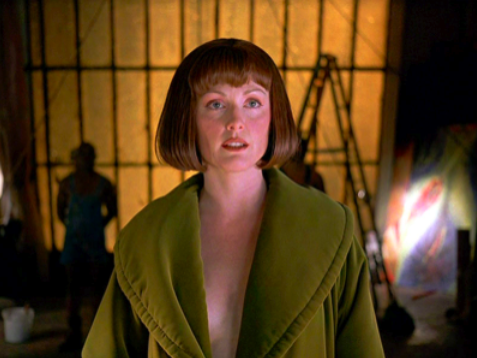The conventions which are as followed are classic/challenged/subverted of film noir:
Opening Credits
- The Opening credits of the film contains part narration from ‘The Dude’ whilst also setting the location and the plotline for the film. This is considered a main convention of film noir when the credits are introduced first.
- A Western, slow-paced soundtrack sung by ‘Roy Rogers & Sons Of The Pioneers – Tumbling Tumbleweeds’ is also accompanied by some fashioned styled text on screen. The text resembles a sort of Western/cowboy genre which is supported by the following camera-shot of the tumbleweed on screen. This is a classic film noir convention, introducing, a soundtrack into the opening of the film.
Characters/ Common Archetypes
- Introduction of the main protagonist (‘The Dude’) implies the classic character archetype ‘The man who is doomed’ after thugs break into his house and begin to interrogate him over money issues. However, ‘The Dude’ seemingly laughs of their threat to him and they leave in disgust. The way The Dude has no serious interest and acts so casual challenges the genre of the film and introduces an element of comedy to a should-be dark and gritty noir.
- The Dude also uses dry humour which is included in the scene where the thugs begin to leave, The dude responds with “At least I’m housebroken!” Snide comments and remarks are quite common amongst film noir.
- Maude and Bunny Lebowski could be potentially classed as femme fatale’s, Maude more so as she ends up sleeping with The Dude at his house, following this classic convention.
Plot
- The Dude is drawn into a seemingly simple yet dangerous plan, acting as a money courier for The Big Lebowski.
- The Dude reaches a dilemma in the plot; Keep the money for himself and friends and be responsible for the death of Bunny Lebowski (The Big Lebowski’s wife) or trying to reclaim the money which has been stolen and hand it over in exchange for the women. He Quickly turns into ‘The man with no future’ as The Big Lebowski threatens to hurt him if his wife dies, Jack Treehorn’s thugs threaten to beat him up and the Nihilist trio want the money in exchange for the women.
Props
- Alcohol and cigarettes appear frequently throughout the film which is are classic conventions of film noir.
- Use of firearms when Walter pulls out a pistol against bowling competitor ‘Smokey’, ordering him to mark his score down.
Camera Shots
- Many Low-angled camera shots are used, especially in the bowling alley. The camera focuses on the bowling balls and pins and also the bowlers footwork and technique. This subverts the standard long shots and ‘Dutch angles’ used of dark alleyways and streets.
Lighting
- When the Dude begins to dream and let his mind wander, he begins to fly through the air through a dark, urban cityscape, displaying all the dark streets and settings of LA.
- Dark lighting exists in interiors in most scenes like when The Dude and Walter Sobchak are driving at night on the freeway devising their plan to take back Lebowski’s wife. Dark lighting is also used conventionally when The Dude is home alone, displaying his isolation and solitary self away from Donny and Walter.
- Shadows and dark lighting exist when The Dude enters Maude Lebowski’s office/studio. This could portray the femme fatale archetype which is about to be displayed to the audience.
- In contrast to this, the bowling alley and The Big Lebowski’s office are examples of subverted lighting conventions, where bright and harsh lighting is used consistently.
- The Office of the police department also includes a set of window blinds, causing a visible background shadow across the scene. This is a classic convention, mainly used to suggest mystery and curiosity across a certain character.
Comparison with a classic film noir (‘The Big Sleep 1946’)
- Both plots are full of twists and turns which will leave the audience confused in parts.They are also both set in the urban setting of Los Angeles. This is very important as LA is considered as the origin of crime, including dark alleyways and cobbled streets reflecting the film noir genre.
- The plot in both films revolves around an old-aged millionaire who faces a dilemma relating to ties with a younger women of some sort. This storyline will cause the main protagonist to be sucked in until the end when he/she must resolve the problem.
- The films introduces the two younger women who are tied down to the millionaires as having associations with gambling and links to the pornography industry. Carmen Sherwood in ‘The Big Sleep’ and Bunny Lebowski in ‘The Big Lebowski’.
- The femme fatale’s throw the male protagonists investigations into disrepute, sending them around in a loop. Vivian Rutledge and Maude Lebowski are responsible for causing the drama.
- A poisoned drink is used in both films to subdue a character who is about to conclude the story. In ‘The Big Sleep’ however, the drink proves to be fatal and ends up killing the main investigator.
- In comparison, a ransom note is used to determine the plot for the film which has been directly sent to the millionaires. Whilst the main protagonists try to investigate, they realise that they are both being tailed by a private detective, making sure they are on track to retrieve their ‘prized possessions’.


